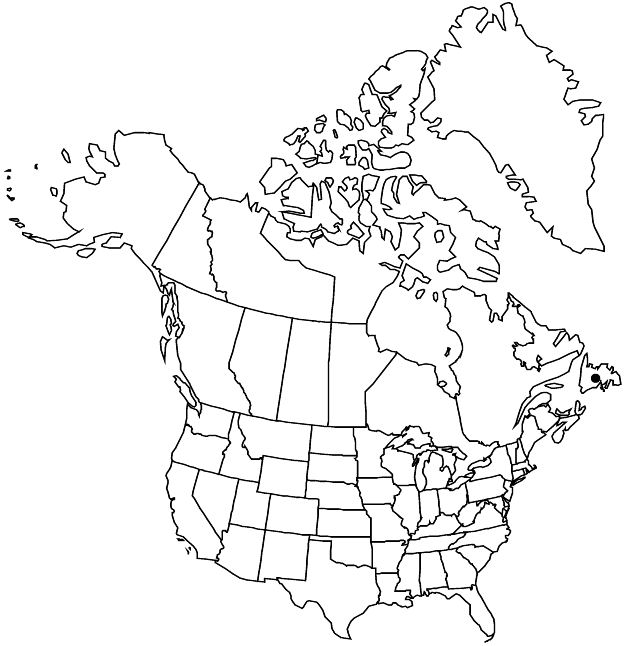Difference between revisions of "Potentilla sterilis"
Fl. N. Mitt.-Deutschland ed. 4, 112. 1858.
FNA>Volume Importer |
imported>Volume Importer |
||
| (3 intermediate revisions by 2 users not shown) | |||
| Line 15: | Line 15: | ||
|name=Fragaria sterilis | |name=Fragaria sterilis | ||
|authority=Linnaeus | |authority=Linnaeus | ||
| + | |rank=species | ||
|publication_title=Sp. Pl. | |publication_title=Sp. Pl. | ||
|publication_place=1: 495. 1753 | |publication_place=1: 495. 1753 | ||
| Line 33: | Line 34: | ||
|elevation=0 m | |elevation=0 m | ||
|distribution=Nfld. and Labr. (Nfld.);Europe. | |distribution=Nfld. and Labr. (Nfld.);Europe. | ||
| + | |introduced=true | ||
|discussion=<p><i>Potentilla sterilis</i> was collected from the coast of Newfoundland in 1928 (A. M. Ayre s.n., GH); no recent documentation of occurrence is known (J. Maunder, pers. comm. to L. Brouillet). Although previously treated as native (M. L. Fernald 1950; E. Hultén and M. Fries 1986), this status has been challenged (for example, A. Kurtto et al. in J. Jalas et al. 1972+, vol. 13). According to H. A. Gleason and A. Cronquist (1991), the species is also rarely introduced in the eastern United States; no vouchers have been seen.</p><!-- | |discussion=<p><i>Potentilla sterilis</i> was collected from the coast of Newfoundland in 1928 (A. M. Ayre s.n., GH); no recent documentation of occurrence is known (J. Maunder, pers. comm. to L. Brouillet). Although previously treated as native (M. L. Fernald 1950; E. Hultén and M. Fries 1986), this status has been challenged (for example, A. Kurtto et al. in J. Jalas et al. 1972+, vol. 13). According to H. A. Gleason and A. Cronquist (1991), the species is also rarely introduced in the eastern United States; no vouchers have been seen.</p><!-- | ||
--><p><i>Potentilla sterilis</i> is superficially similar to strawberry (<i>Fragaria</i>) but lacks the fleshy fruit; other differences include stolon structure, anther morphology, and style length and attachment.</p> | --><p><i>Potentilla sterilis</i> is superficially similar to strawberry (<i>Fragaria</i>) but lacks the fleshy fruit; other differences include stolon structure, anther morphology, and style length and attachment.</p> | ||
| Line 43: | Line 45: | ||
-->{{#Taxon: | -->{{#Taxon: | ||
name=Potentilla sterilis | name=Potentilla sterilis | ||
| − | |||
|authority=(Linnaeus) Garcke | |authority=(Linnaeus) Garcke | ||
|rank=species | |rank=species | ||
| Line 59: | Line 60: | ||
|publication year=1858 | |publication year=1858 | ||
|special status=Introduced | |special status=Introduced | ||
| − | |source xml=https:// | + | |source xml=https://bitbucket.org/aafc-mbb/fna-data-curation/src/2e0870ddd59836b60bcf96646a41e87ea5a5943a/coarse_grained_fna_xml/V9/V9_189.xml |
|subfamily=Rosaceae subfam. Rosoideae | |subfamily=Rosaceae subfam. Rosoideae | ||
|tribe=Rosaceae tribe Potentilleae | |tribe=Rosaceae tribe Potentilleae | ||
Latest revision as of 22:54, 5 November 2020
Basal leaves: petiole 2–7(–17) cm, long hairs common to abundant, 1–2 mm; central leaflets (0.8–)1.5–3(–5) × (0.6–)1–2(–3) cm, straight hairs common to abundant (sparser adaxially), glands absent or sparse. Flowers: epicalyx bractlets ± lanceolate, 2.5–4 × 0.8–1.3 mm; sepals 4–6.5 mm, apex ± acute; petals 4–7 × 3–5 mm; filaments 0.8–2 mm, anthers 0.6–0.9 mm; carpels numerous. Achenes 1.5 mm. 2n = 28 (Europe).
Phenology: Flowering spring.
Habitat: Dry to moist, often rocky slopes
Elevation: 0 m
Distribution

Introduced; Nfld. and Labr. (Nfld.), Europe.
Discussion
Potentilla sterilis was collected from the coast of Newfoundland in 1928 (A. M. Ayre s.n., GH); no recent documentation of occurrence is known (J. Maunder, pers. comm. to L. Brouillet). Although previously treated as native (M. L. Fernald 1950; E. Hultén and M. Fries 1986), this status has been challenged (for example, A. Kurtto et al. in J. Jalas et al. 1972+, vol. 13). According to H. A. Gleason and A. Cronquist (1991), the species is also rarely introduced in the eastern United States; no vouchers have been seen.
Potentilla sterilis is superficially similar to strawberry (Fragaria) but lacks the fleshy fruit; other differences include stolon structure, anther morphology, and style length and attachment.
Selected References
None.